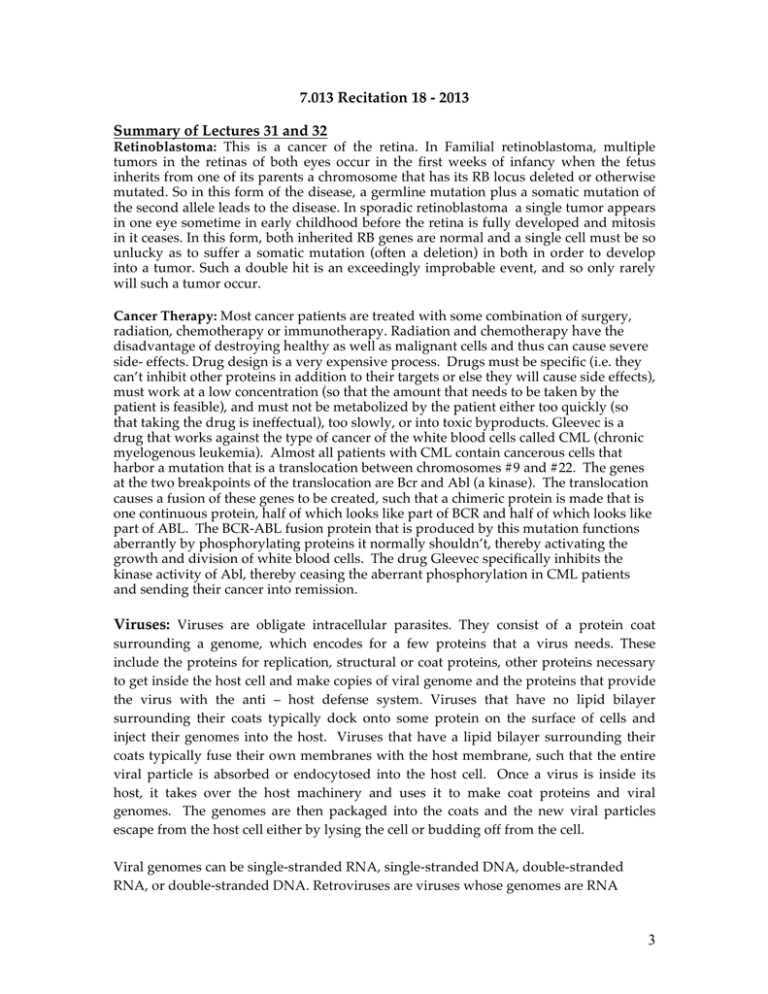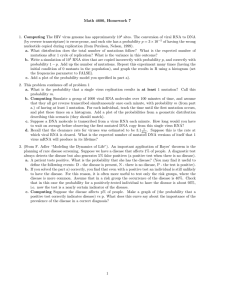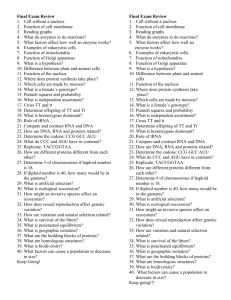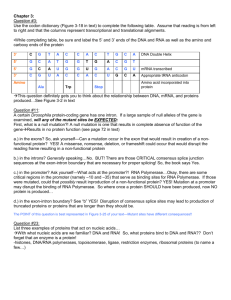7.013 Recitation 18 - 2013 Summary of Lectur es 31 and 32
advertisement

7.013 Recitation 18 - 2013 Summary of Lectures 31 and 32 Retinoblastoma: This is a cancer of the retina. In Familial retinoblastoma, multiple tumors in the retinas of both eyes occur in the first weeks of infancy when the fetus inherits from one of its parents a chromosome that has its RB locus deleted or otherwise mutated. So in this form of the disease, a germline mutation plus a somatic mutation of the second allele leads to the disease. In sporadic retinoblastoma a single tumor appears in one eye sometime in early childhood before the retina is fully developed and mitosis in it ceases. In this form, both inherited RB genes are normal and a single cell must be so unlucky as to suffer a somatic mutation (often a deletion) in both in order to develop into a tumor. Such a double hit is an exceedingly improbable event, and so only rarely will such a tumor occur. Cancer Therapy: Most cancer patients are treated with some combination of surgery, radiation, chemotherapy or immunotherapy. Radiation and chemotherapy have the disadvantage of destroying healthy as well as malignant cells and thus can cause severe side- effects. Drug design is a very expensive process. Drugs must be specific (i.e. they can’t inhibit other proteins in addition to their targets or else they will cause side effects), must work at a low concentration (so that the amount that needs to be taken by the patient is feasible), and must not be metabolized by the patient either too quickly (so that taking the drug is ineffectual), too slowly, or into toxic byproducts. Gleevec is a drug that works against the type of cancer of the white blood cells called CML (chronic myelogenous leukemia). Almost all patients with CML contain cancerous cells that harbor a mutation that is a translocation between chromosomes #9 and #22. The genes at the two breakpoints of the translocation are Bcr and Abl (a kinase). The translocation causes a fusion of these genes to be created, such that a chimeric protein is made that is one continuous protein, half of which looks like part of BCR and half of which looks like part of ABL. The BCR-ABL fusion protein that is produced by this mutation functions aberrantly by phosphorylating proteins it normally shouldn’t, thereby activating the growth and division of white blood cells. The drug Gleevec specifically inhibits the kinase activity of Abl, thereby ceasing the aberrant phosphorylation in CML patients and sending their cancer into remission. Viruses: Viruses are obligate intracellular parasites. They consist of a protein coat surrounding a genome, which encodes for a few proteins that a virus needs. These include the proteins for replication, structural or coat proteins, other proteins necessary to get inside the host cell and make copies of viral genome and the proteins that provide the virus with the anti – host defense system. Viruses that have no lipid bilayer surrounding their coats typically dock onto some protein on the surface of cells and inject their genomes into the host. Viruses that have a lipid bilayer surrounding their coats typically fuse their own membranes with the host membrane, such that the entire viral particle is absorbed or endocytosed into the host cell. Once a virus is inside its host, it takes over the host machinery and uses it to make coat proteins and viral genomes. The genomes are then packaged into the coats and the new viral particles escape from the host cell either by lysing the cell or budding off from the cell. Viral genomes can be single-­‐‑stranded RNA, single-­‐‑stranded DNA, double-­‐‑stranded RNA, or double-­‐‑stranded DNA. Retroviruses are viruses whose genomes are RNA 3 strands that are converted to DNA upon entry into the cell. Retroviral genomes contain a gene that encodes the enzyme Reverse Transcriptase (RT). Reverse transcriptase is a DNA polymerase that reads a strand of RNA as a template, and synthesizes the complementary strand of DNA. Retroviruses use RT to convert their RNA genomes into DNA such that these pieces of DNA can now randomly integrate into the host cell’s genome. In this way, the virus hides out in a chromosome and gets replicated and passed on to all daughter cells of the original cell it infected. Questions: 1. Retinoblastoma is caused by the mutation in the retinoblastoma tumor suppressor gene. There are several mechanisms, which can cause a cell to lose its normal gene and thus be predisposed to develop into a tumor. These may result in a "loss of heterozygosity" or "LOH". § What do you mean by LOH? § Many clinicians and scientists are currently trying to develop cancer treatments that are more specific and targeted than chemotherapy. If a patient had a tumor that was caused in part by mutations in Rb. Do you think it would be a good therapeutic decision to provide this cancer patient with a wild-type copy of the Rb gene? 2. Why do some people think that viruses are alive and some people don’t? 4. Could you treat a viral infection by antibiotics (Yes/No)? Explain. 5. What is the genetic material (DNA / RNA) in a plus and minus stranded virus? How does a plus stranded virus differ from a minus stranded virus? 6. The following sequence is a short viral gene from a double-­‐‑stranded DNA virus that actually encodes three different proteins. The sequence shown is from the transcription start site to the transcriptional end site. The upper strand of this gene is used as a template in transcription. 5’TACTCTATCGCTTTAGCGGTATGCTATCAGAGCCATGCATGCATC 3’ 3’ATGAGATAGCGAAATCGCCATACGATAGTCTCGGTACGTACGTAG 5’ i. How do you know that it is true that these three short proteins are not produced from alternative splicing of a single transcript? ii. How many amino acids long would each of the three proteins be that are produced from this gene? 4 iii. What is a major advantage for the virus to using this strategy? iv. What is a major disadvantage for the virus to using this strategy? 5 MIT OpenCourseWare http://ocw.mit.edu 7.013 Introductory Biology Spring 2013 For information about citing these materials or our Terms of Use, visit: http://ocw.mit.edu/terms.









